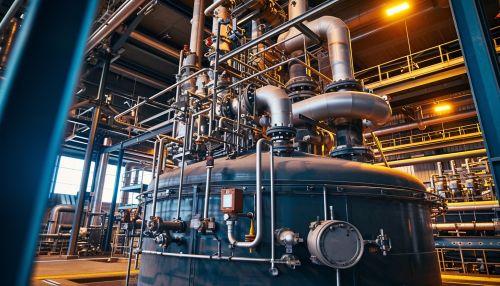Entrained flow gasifier
Introduction
An Entrained flow gasifier is a type of gasifier that operates at high temperatures and pressures. It is characterized by the high velocity at which the gasification reaction takes place, with the feedstock and gasification agent being mixed and reacted in an "entrained" state. This process is commonly used in the production of synthetic fuels, power generation, and chemical production.
Principle of Operation
The entrained flow gasifier operates on the principle of thermodynamics, chemical kinetics, and fluid dynamics. The feedstock, usually a type of coal, biomass, or petroleum coke, is pulverized and mixed with a gasification agent, typically oxygen, steam, or a mixture of both. This mixture is then fed into the gasifier at high velocities, creating a state of entrainment.


The high temperatures and pressures inside the gasifier facilitate the gasification reaction, converting the feedstock into syngas, a mixture of carbon monoxide and hydrogen. The syngas is then cooled and cleaned before being used in subsequent processes.
Design and Construction
The design and construction of an entrained flow gasifier are crucial to its operation and efficiency. The gasifier is typically a tall, cylindrical vessel made of high-strength steel or refractory materials to withstand the high temperatures and pressures. The feedstock and gasification agent are introduced at the top of the gasifier, while the syngas and byproducts are collected at the bottom.
The gasifier is equipped with a system for feedstock preparation, a gasification agent supply system, a syngas cooling and cleaning system, and a byproduct disposal system. The design and configuration of these systems can vary depending on the type of feedstock, the desired syngas composition, and the specific application of the gasifier.
Applications
Entrained flow gasifiers have a wide range of applications in various industries. In the energy sector, they are used in the production of synthetic fuels and power generation. In the chemical industry, they are used to produce chemicals such as methanol, ammonia, and hydrogen. They are also used in the production of fertilizers, plastics, and other petrochemical products.
Advantages and Disadvantages
Entrained flow gasifiers offer several advantages over other types of gasifiers. They operate at high temperatures and pressures, which results in a high gasification efficiency and a high-quality syngas. They can handle a wide range of feedstocks, including low-grade coals and biomass. They also produce a low amount of byproducts, reducing the environmental impact.
However, entrained flow gasifiers also have some disadvantages. They require a high energy input due to the high operating temperatures and pressures. The feedstock needs to be finely pulverized, which adds to the operational cost. The high temperatures can also lead to the formation of slag, which can cause operational issues.
Future Perspectives
With the increasing demand for clean and sustainable energy sources, the role of entrained flow gasifiers is expected to grow in the future. Advances in technology and materials science are likely to improve the efficiency and reliability of these gasifiers. Research is also being conducted on using alternative feedstocks, such as waste materials and renewable biomass, to further enhance the sustainability of this technology.
